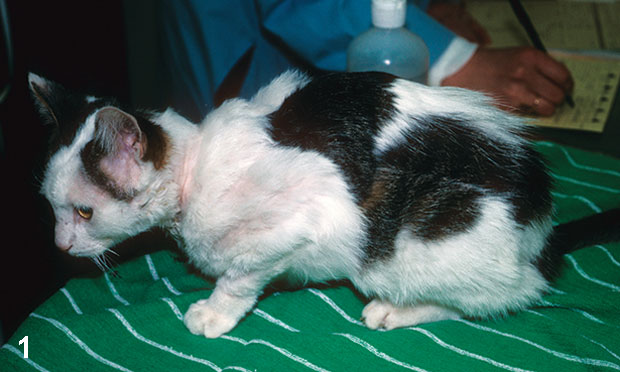Pruritus in dogs and cats
What is pruritus?
Pruritis is the medical term for the sensation of itchy skin that provokes the need to scratch, lick, rub, chew or bite at the skin, thereby causing inflammation. Pruritus is a clinical sign or indicator of inflamed skin and is not a diagnosis or specific disease. It is a common occurrence in skin disorders, parasitic infections, skin allergies, tick and flea infestations, and several other conditions. Sometimes, it is caused by a serious underlying medical condition.
Pruritus is common in dogs and cats. Even the act of scratching at an itch itself, can contribute to inflammation and pruritus in animals. The condition can be very uncomfortable, manifesting as a sharp or diffuse burning sensation. It can be mild and have little effect on the animal’s health, or it can be severe, and scratching and chewing can lead to hair loss, injuries, and pain. The itching sensation may be generalised or confined to one area (localized).

Symptoms of pruritus in dogs and cats
Most dogs and cats have frequent minor itches that are relieved by scratching or chewing. An animal with pruritus, however, will excessively scratch, bite, or lick its itching skin. Almost any skin-covered area of the body can be affected, including the back, belly, elbows, groin, sides, genitals and anus. Severity of the symptoms can vary considerably between animals, with some experiencing ongoing itching and others having waxing and waning irritation. In most cases, it is likely that several of the following symptoms of pruritus will appear:
Behavioural symptoms:
- Scratching excessively at the skin
- Licking, chewing, biting
- Chewing or biting
- Rubbing against surfaces and objects
- Self-trauma
- Vocalisation
- Wincing
- Other expressions of pain
- Protecting certain areas of the body
- Odd behaviour, e.g. walking in circles, particularly if the itch is in a hard-to-reach location such as the base of the tail or the back
- Scooting on its bottom (if the anal area is affected)
- Repetitive shaking of the ears, head or body
- Sleep disturbances
Skin-related symptoms at the site:
- Injury to the skin, e.g. scabs, lesions
- Inflammation
- Scaling
- Bad odour
- Swelling
- Redness
- Discolouration
- Pigmentation
- Skin infection
- Fluid discharge
- Greasy seborrhoea (excessively oily skin)
- Bald patches or loss of hair (alopecia)
- Lick granuloma (raised, ulcerated skin, especially on the wrists or ankles)
Causes of pruritus in dogs and cats
There are many possible causes of pruritus in dogs and cats. Skin disease is one of the most common, but there are several other conditions that can lead to persistent itchiness, including parasites, infections and allergies. In addition, there are many diseases that do not initially cause itching, but itching may develop because of secondary bacterial or yeast infections. The sensation of pruritus may be influenced by a variety of factors, including boredom, stress and anxiety.
Possible causes of pruritus include:
- Parasitic infestation:
- Mange (a skin disease caused by parasitic mites)
- Scabies (a type of mange caused by a particular family of mites)
- Other parasites such as lice, fleas and ticks
- Intestinal worms
- Allergies:
- Seasonal allergy e.g. pollen, mould,
- Food allergy
- Environmental allergen, e.g. dust, dust mites
- Insect bite e.g. flea allergy, mosquito bite allergy, fly bite
- Drug reaction, e.g. aspirin, opiate
- Skin conditions:
- Atopic dermatitis (eczema), a chronic, inflammatory skin disease associated with allergies to particular substances
- Contact dermatitis, a skin disease that occurs from physical contact with a chemical or other irritating substance
- Urticaria (hives), a skin rash with red, raised, itchy bumps
- Dry skin
- Aged, thin skin
- Microbial infections:
- Staphylococcal (bacterial) infection
- Malassezia (yeast) overgrowth
- Dermatophytosis (ringworm, a fungal infection)
- Pyoderma (bacterial infection)
- Concurrent bacterial and yeast infections
- Injury, sometimes self-inflicted from trying to relieve itchiness from another condition
- Immune disorders
- Abnormal cell development (neoplasia)
- Chronic renal failure
- Cholestasis (a reduction or stoppage of bile flow)
- HIV infection
- Diabetes mellitus
- Iron deficiency
- Psychogenic (physical illness arising from psychological factors, e.g. boredom, anxiety, stress)
- Idiopathic (no identifiable cause)

How is pruritus in dogs and cats diagnosed?
It is important to consult with a veterinarian if an animal is exhibiting signs of pruritus and persistently trying to relieve itchiness, in order to determine the cause and prescribe treatment. The veterinarian will take a thorough dermatologic history and perform a physical examination of the affected area. In addition, certain tests can be done to help determine the cause.
Parasites
An important initial step in diagnosing pruritus is to confirm or exclude parasites. If mites are suspected, skin scrapings can be taken for pathology testing. However, some mite infestations can be missed on skin scrapings, therefore anti-parasitic medication may still be prescribed without a positive finding.
Infections
The next most important group of pruritic diseases to confirm or exclude is infectious causes of skin disease, both bacterial and fungal. A fungal culture should be performed in any cat presenting with pruritus and is also highly recommended in dogs that are newly acquired, any animal with a possible history of exposure to skin infections and/or compatible clinical signs.
Because allergy testing and skin biopsies are fairly expensive and invasive diagnostic tests, the veterinarian may prescribe a course of antibiotic and/or anti-fungal medication as a first step, in order to exclude a bacterial infection or a concurrent bacterial and yeast infection. For example, bacterial pyoderma is under-diagnosed in cats, and a trial of appropriate antibiotic medication may be needed to exclude or include it. If the pruritus resolves after the course of medication, then the cause is determined as a microbial infection. If not, other diagnostic testing may then proceed. (Source)
Allergies
Once parasites and microbial infections have been excluded, the probable underlying cause is an allergic reaction. It is possible that the trigger allergen has long gone or is seasonal. However, if the animal’s pruritus remains unchanged or only slightly improves, the most likely underlying cause is insect bite hypersensitivity, a food allergy or atopic dermatitis.
Allergic reaction to flea and insect bites are excluded based on the animal’s response to insect control treatments. Animals that do not have insect bite hypersensitivity but are seasonally pruritic most likely have atopic dermatitis. Animals with year-round allergic pruritus tend to have atopic dermatitis and/or a food allergy. Food allergy is excluded or included based on the animal’s response to a diet trial and food challenge tests.
Allergy testing may be performed as a diagnostic aid, in particular to identify the cause of atopic dermatitis. Allergy testing is useful in order to:
- Measure the levels of antibodies produced by the immune system in response to the allergen
- Identify the particular allergen responsible for the reaction
- Formulate a specific immunotherapy vaccine that targets the offending allergen
The two most common types of allergy tests used in pets are intra-dermal skin testing and serum allergy testing:
- Intra-dermal skin testing – using very small needles, tiny amounts of each test allergen are injected just under the skin in different areas. After short time, the injection sites are examined to measure the degree of local allergic response, such as redness or a small hive. Allergens to which the animal is not allergic to will not cause a reaction, while allergens to which the animal is allergic to will cause a reaction that corresponds to the severity of the allergy.
- Serum allergy testing – a small blood sample is taken from the animal and sent to a laboratory for analysis. The results can reveal which allergens are not causing an allergic reaction, which ones are causing a mild reaction, and which ones are causing a more serious reaction.

Source: https://files.brief.vet/migration/article/14571/myd-fel-demodex-fig-1-14571-article.jpg
Prognosis
Without treatment, pruritis usually gets worse, resulting in partial or full hair loss, damage to the skin and secondary bacterial skin infections. This can have an increasingly negative effect on the animal’s quality of life and behaviour. However, if the signs are recognised and the cause identified early on, the prognosis is positive. The condition can be effectively managed, and with appropriate treatment the animal’s comfort and well-being can be greatly improved. There are currently no known preventative measures, but with maintenance and treatment, recurrence can be avoided or minimised.
Treatment for pruritus in dogs and cats
The treatment given will be dependent upon the underlying cause for the condition. The main goals are to remove the source of irritation and inflammation from the skin and to relieve itching.
Medical management
If the cause of pruritus cannot be identified, or where treatment of the underlying disease does not eliminate the itching, medication will be prescribed to minimise or eliminate the desire to scratch. Medicine may be given orally, by injection, or as a topical (external) ointment. Commonly prescribed anti-itching medications include:
- Glucocorticoids (anti-inflammatorysteroid hormones) – these are very effective but have adverse side effects and cannot be used long-term; however, topical sprays can be an effective alternative to tablets.
- Antihistamines – commonly prescribed for seasonal allergies and some forms of contact dermatitis, these can have highly variable success rates.
- Essential fatty acids,g. glinolenic acid, can be successful when used long-term, particularly for conditions such as dry skin.
- Immunosuppressants / immunomodulators (medicines that change the activity of the immune system), e.g. modified cyclosporine and oclacitinib, can be highly effective.
- Antibiotics – prescribed when bacterial or concurrent yeast and bacterial infections are suspected.
Other treatments
- If the animal’s diet is identified or suspected, dietary modifications will be recommended.
- Flea infestations are treated with medications and special shampoos, as well as preventative medication that is administered monthly or at various times throughout the year. Natural flea treatments are also available.
- Tick and lice infestations may also be treated with medication or by natural means.
- Use of an Elizabethan collar, cone or similar device to prevent the animal from chewing or scratching at the site of itchiness until the area heals; this will also prevent ingestion of any topical treatments.
- Avoidance of trigger allergens; this may be the best option, but can only be accomplished if a specific allergen has been identified.
- Allergen-specific immunotherapy (ASIT) may be performed.

In summary
Pruritus is the medical term for the sensation of intense itchiness that provokes the urge to scratch, chew, lick, or rub the hair and skin, causing inflammation. Pruritus is a common symptom of several skin conditions in dogs and cats. The most common causes are parasites, bacterial and fungal infections, and allergies.
Intense scratching can eventually lead to partial or full hair loss, but with treatment, prognosis is positive. The veterinarian will examine the sites that are most affected on the skin and perform tests to determine the cause. Treatment may entail medication to alleviate the itching and/or treatment or strategies to eliminate the underlying cause.
Bow Wow Meow Pet Insurance can help protect you and your pet should an unexpected trip to your vet occur.
- Find out more about our dog insurance options
- Find out more about our cat insurance options
- Get an instant online pet insurance quote
Bow Wow Meow is proud to have been awarded winner of Canstar’s ‘Most Satisfied Customers’ Award in the Pet Insurance category for both 2024 and 2025!
Bow Wow Meow is proud to have been chosen as Product Review’s Pet Insurance Award Winner every year from 2018 to 2025! This is based on 2,995 independent customer reviews (as at 21/01/2025), with an overall rating of 4.3*
Google Review rating = 4.5* (based on 968 reviews)
Trust Pilot rating = 4.6* (based on 531 reviews)
Bow Wow Meow is proud to have been chosen as Product Review’s Pet Insurance Award Winner every year from 2018 to 2025! This is based on 2,995 independent customer reviews (as at 21/01/2025), with an overall rating of 4.3*
Google Review rating = 4.5* (based on 968 reviews)
Trust Pilot rating = 4.6* (based on 531 reviews)
Bow Wow Meow has been chosen as a winner in the Finder Pet Insurance Awards 2024. Finder’s panel of experts analysed over 140 quotes to award our Ultimate Care Plan the winner of the “Pet Insurance – Value” category.
More information
- https://www.rcpa.edu.au/Manuals/RCPA-Manual/Clinical-Problems/P/Pruritis
- https://dogtime.com/dog-health/56151-pruritus-itchiness-dogs-symptoms-causes-treatments
- https://www.petmd.com/dog/conditions/skin/c_multi_pruritus
- https://www.petmd.com/cat/conditions/skin/c_ct_pruritus
- https://www.msdvetmanual.com/dog-owners/skin-disorders-of-dogs/itching-pruritus-in-dogs
- https://www.msdvetmanual.com/cat-owners/skin-disorders-of-cats/itching-pruritus-in-cats https://www.msdvetmanual.com/integumentary-system/integumentary-system-introduction/pruritus
- http://www.dogallergiesonline.com/symptoms/allergies-in-dogs/allergies-in-dogs-symptoms-itchiness-pruritus/
- http://www.vetstreet.com/care/allergy-testing
- Bow Wow Meow – Dermatitis in dogs and cats











